CHEVROLET CORVETTE 1997 5.G Owners Manual
Manufacturer: CHEVROLET, Model Year: 1997, Model line: CORVETTE, Model: CHEVROLET CORVETTE 1997 5.GPages: 356, PDF Size: 18.43 MB
Page 291 of 356
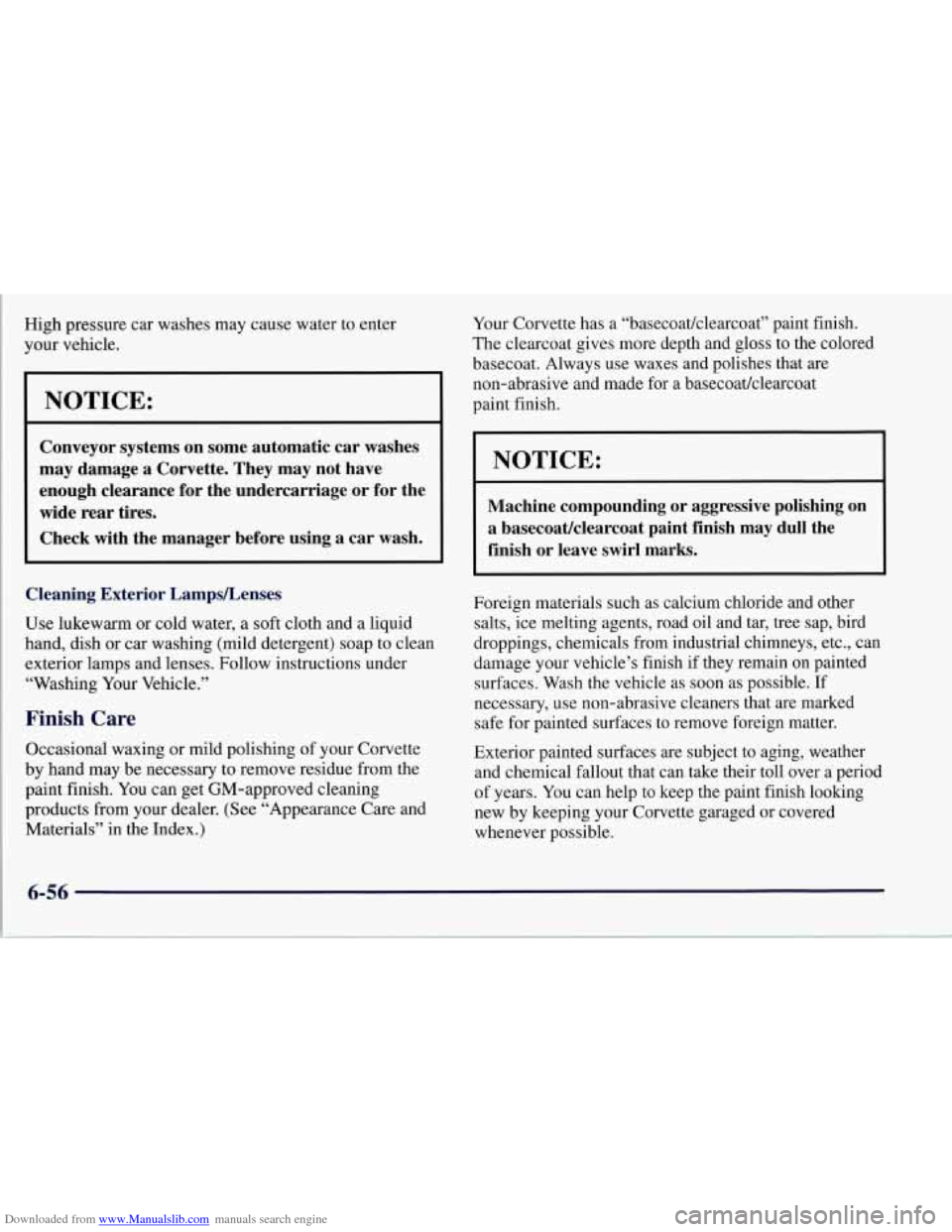
Downloaded from www.Manualslib.com manuals search engine High pressure car washes may cause water to enter
your vehicle.
L
NOTICE:
Conveyor systems on some automatic car washes
may damage a Corvette. They may not have
enough clearance for the undercarriage or for the
wide rear tires.
Check with the manager before using a car wash.
Cleaning Exterior LampsLenses
Use lukewarm or cold water, a soft cloth and a liquid
hand, dish or car washing (mild detergent) soap to clean
exterior lamps and lenses. Follow instructions under
“Washing Your Vehicle.”
Finish Care
Occasional waxing or mild polishing of your Corvette
by hand may be necessary to remove residue from the
paint finish. You can get GM-approved cleaning
products from your dealer.
(See “Appearance Care and
Materials” in the Index.) Your
Corvette has a “basecoatklearcoat” paint finish.
The clearcoat gives more depth and gloss to the colored
basecoat. Always use waxes and polishes that are
non-abrasive and made for a basecoatklearcoat
paint finish.
I NOTICE:
Machine compounding or aggressive polishing on
a basecoatklearcoat paint finish may dull the
finish or leave swirl marks.
Foreign materials such as calcium chloride and other
salts, ice melting agents, road oil and tar, tree sap, bird
droppings, chemicals from industrial chimneys, etc., can
damage your vehicle’s finish if they remain on painted
surfaces. Wash the vehicle as soon as possible. If
necessary, use non-abrasive cleaners that are marked
safe for painted surfaces to remove foreign matter.
Exterior painted surfaces are subject to aging, weather
and chemical fallout that can take their toll over
a period
of years. You can help to keep the paint finish looking
new by keeping your Corvette garaged or covered
whenever possible.
6-56
Page 292 of 356
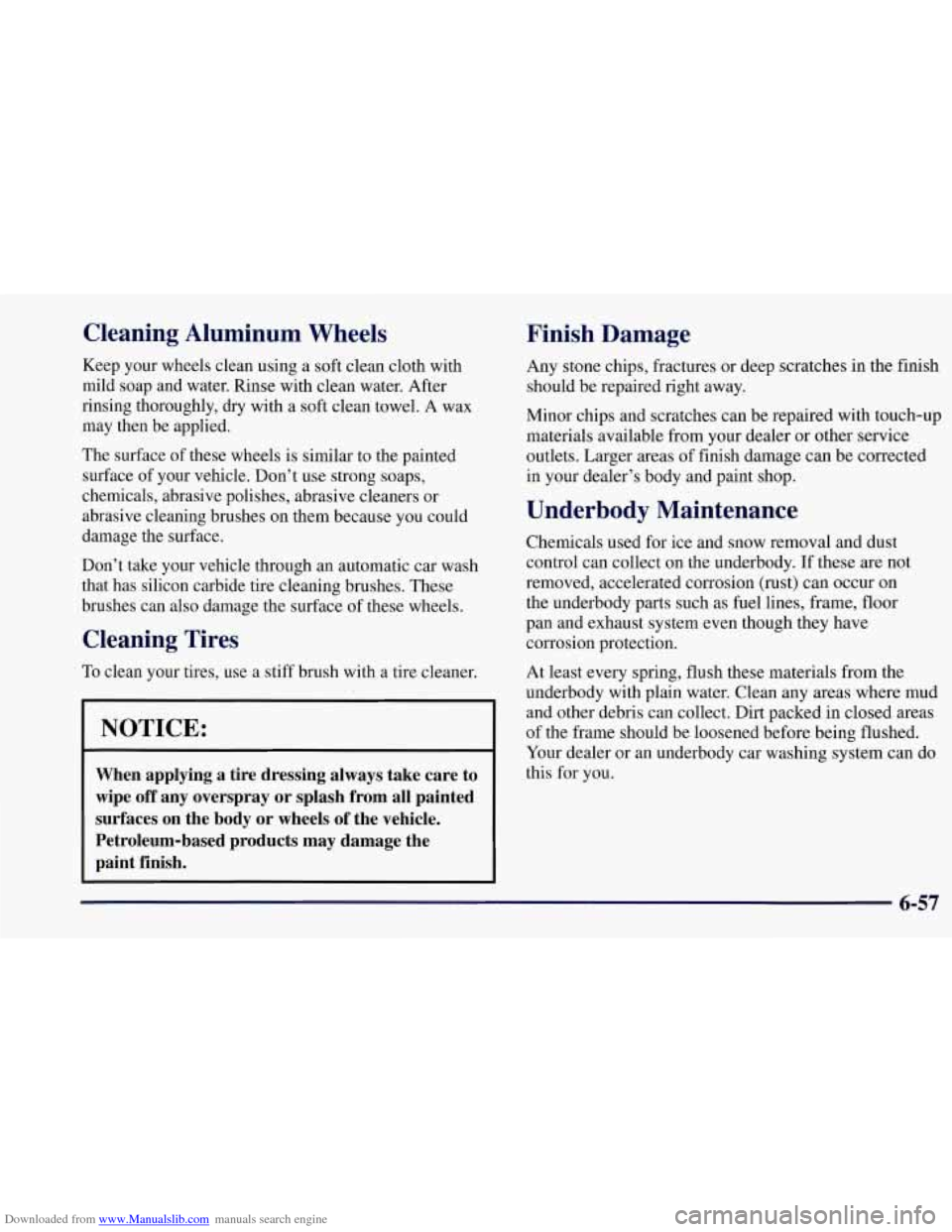
Downloaded from www.Manualslib.com manuals search engine Cleaning Aluminum Wheels
Keep your wheels clean using a soft clean cloth with
mild soap and water. Rinse with clean water. After
rinsing thoroughly, dry with a soft clean towel. A wax
may then be applied.
The surface of these wheels is similar to the painted
surface
of your vehicle. Don’t use strong soaps,
chemicals, abrasive polishes, abrasive cleaners or
abrasive cleaning brushes on them because you could
damage the surface.
Don’t take your vehicle through an automatic car wash
that has silicon carbide tire cleaning brushes. These
brushes can also damage the surface of these wheels.
Cleaning Tires
To clean your tires, use a stiff brush with a tire cleaner.
NOTICE:
When applying a tire dressing always take care to
wipe off any overspray or splash from all painted
surfaces on the body or wheels of the vehicle.
Petroleum-based products may damage the
paint finish.
Finish Damage
Any stone chips, fractures or deep scratches in the finish
should be repaired right away.
Minor chips and scratches can be repaired with touch-up
materials available from your dealer or other service
outlets. Larger areas of finish damage can be corrected
in your dealer’s body and paint shop.
Underbody Maintenance
Chemicals used for ice and snow removal and dust
control can collect
on the underbody. If these are not
removed, accelerated corrosion (rust) can occur on
the underbody parts such as fuel lines, frame, floor
pan and exhaust system even though they have
corrosion protection.
At least every spring, flush these materials from the
underbody with plain water. Clean any areas where mud
and other debris can collect. Dirt packed in closed areas
of the frame should be loosened before being flushed.
Your dealer or an underbody car washing system can do
this for
you.
6-57
Page 293 of 356
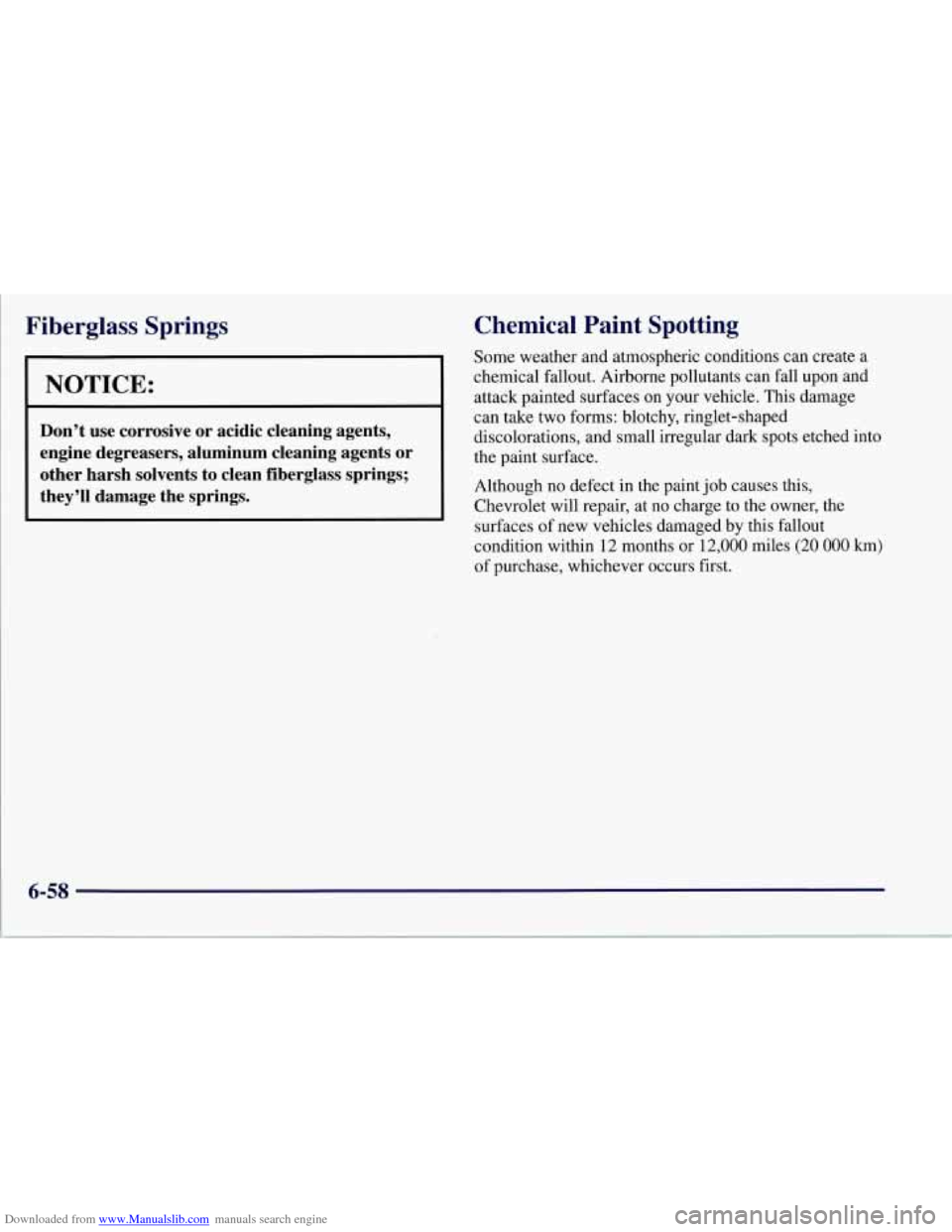
Downloaded from www.Manualslib.com manuals search engine Fiberglass Springs
I NOTICE: I
Don’t use corrosive or acidic cleaning agents,
engine degreasers, aluminum cleaning agents or
other harsh solvents to clean fiberglass springs;
they’ll damage the springs.
Chemical Paint Spotting
Some weather and atmospheric conditions can create a
chemical fallout. Airborne pollutants can fall upon and
attack painted surfaces on your vehicle. This damage
can take two forms: blotchy, ringlet-shaped
discolorations, and small irregular dark spots etched into
the paint surface.
Although no defect
in the paint job causes this,
Chevrolet will repair, at
no charge to the owner, the
surfaces of new vehicles damaged by this fallout
condition within
12 months or 12,000 miles (20 000 km)
of purchase, whichever occurs first.
6-58
Page 294 of 356
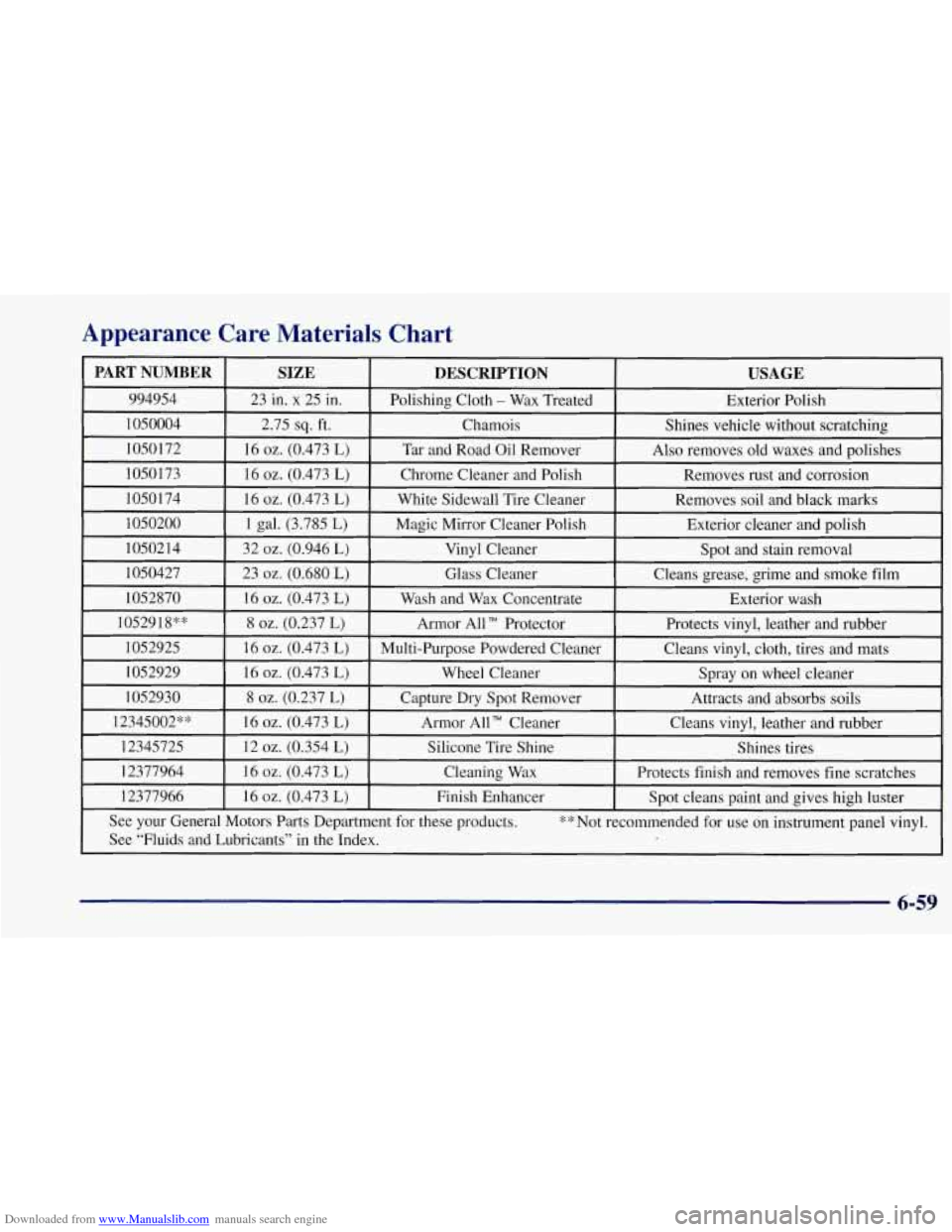
Downloaded from www.Manualslib.com manuals search engine Appearance Care Materials Chart
1052918** 8 oz. (0.237 L) Armor All Protector
Protects vinyl, leather and rubber
1052925 16
oz. (0.473 L) Multi-Purpose Powdered Cleaner Cleans vinyl, cloth, tires and mats
1052929 16 oz. (0.473
L) Wheel Cleaner
Spray on wheel cleaner
1052930
8 oz. (0.237 L)
Capture Dry Spot Remover
Attracts and absorbs soils
12345002** 16
oz. (0.473 L) Armor All TM Cleaner Cleans vinyl, leather and rubber
12345725 12
oz. (0.354 L) Silicone Tire Shine Shines tires
12377964 16
oz. (0.473 L) Cleaning Wax
Protects finish and removes fine scratches
12377966 16
oz. (0.473 L) Finish
Enhancer
Spot cleans paint and gives high luster
See your General Motors Parts Department for these products. **Not recommended for
use on instrument panel vinyl.
See “Fluids and Lubricants’’ in the Index.
6-59
Page 295 of 356
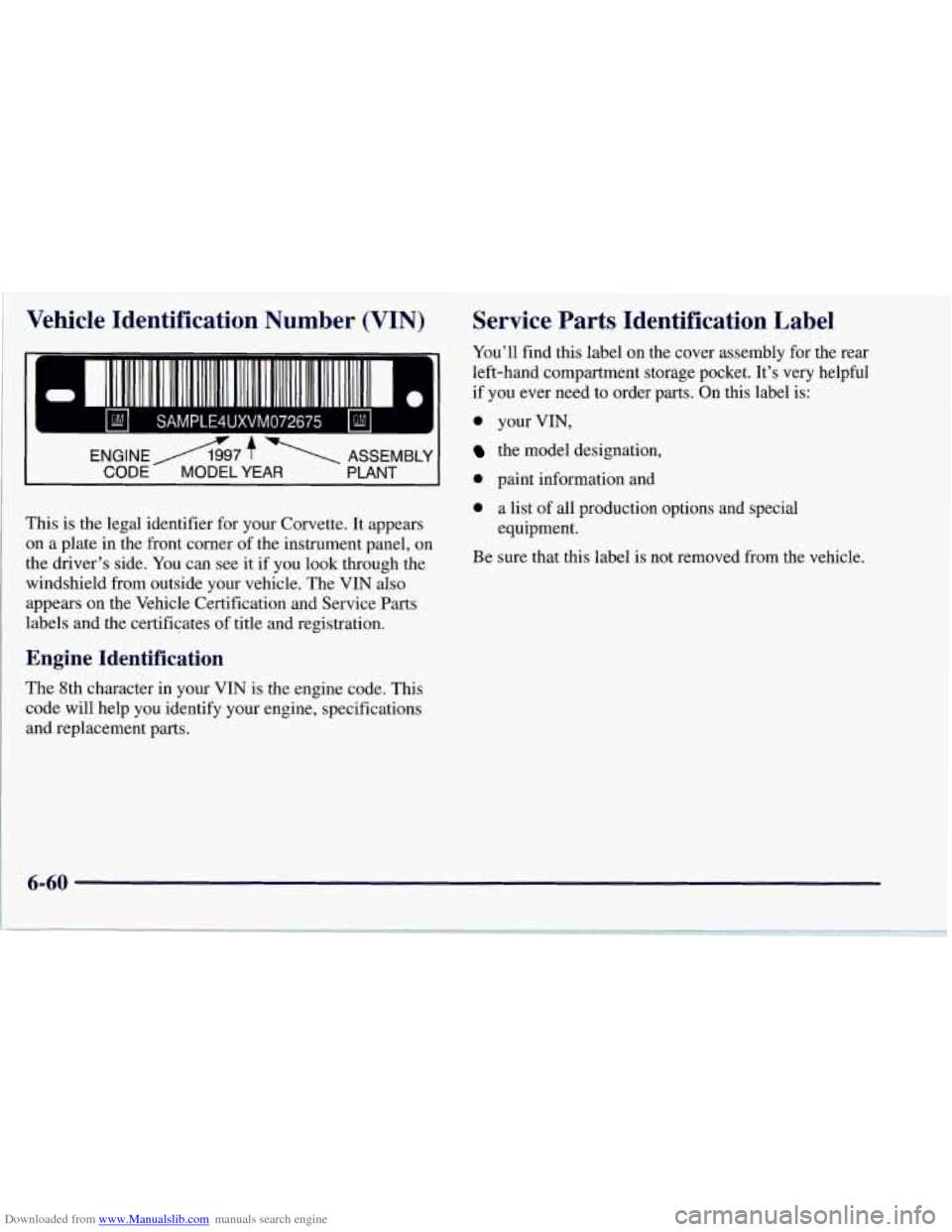
Downloaded from www.Manualslib.com manuals search engine Vehicle Identification Number (VIN)
- -
This is the legal identifier for your Corvette. It appears
on a plate in the front corner
of the instrument panel, on
the driver’s side. You can see it
if you look through the
windshield from outside your vehicle. The VIN also
appears on the Vehicle Certification and Service Parts
labels and the certificates of title and registration.
Engine Identification
The 8th character in your VIN is the engine code. This
code will help you identify your engine, specifications
and replacement parts.
Service Parts Identification Label
You’ll find this label on the cover assembly for the rear
left-hand compartment storage pocket. It’s very helpful
if you ever need to order parts. On this label is:
0 your VIN,
the model designation,
0 paint information and
0 a list of all production options and special
Be sure that this label is not removed from the vehicle.
equipment.
6-60
Page 296 of 356
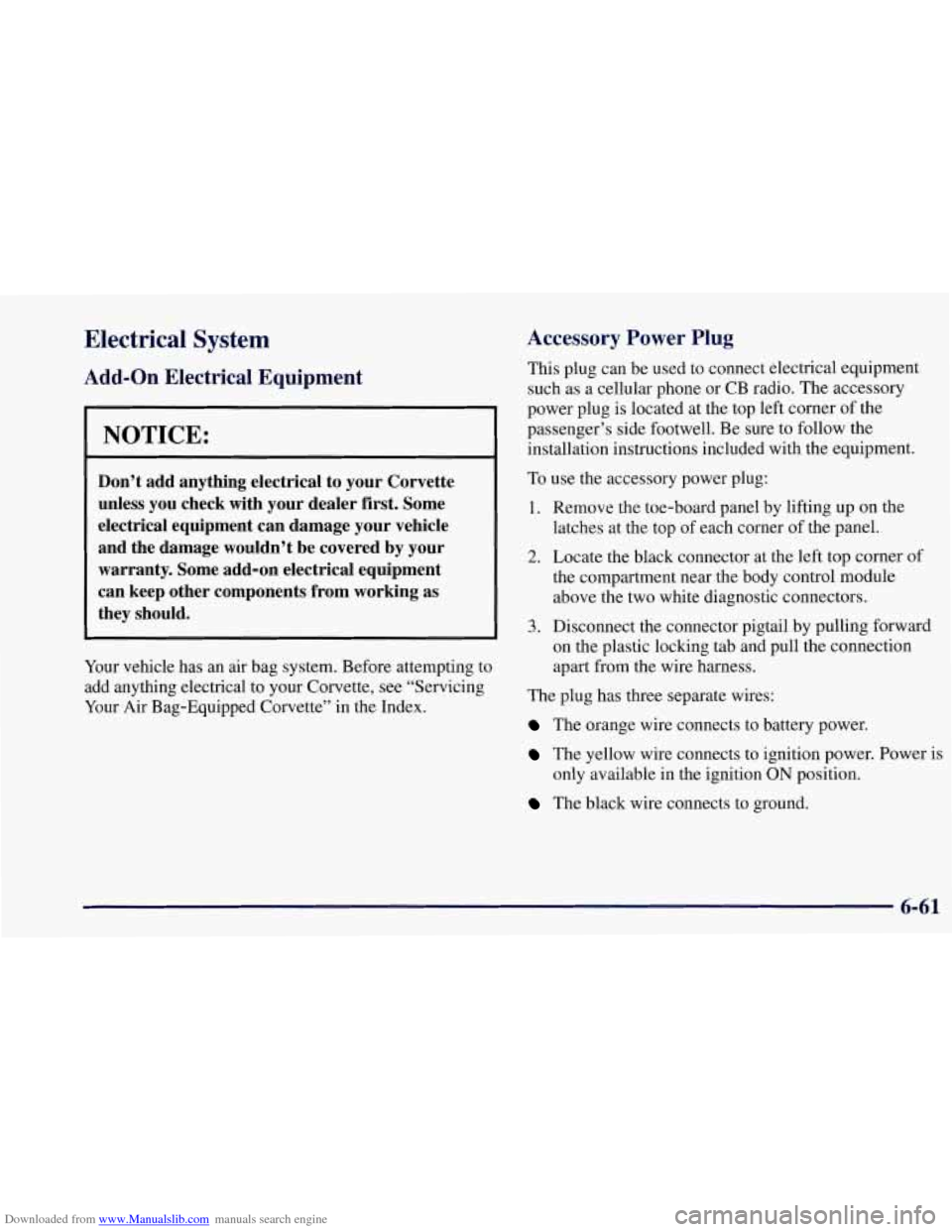
Downloaded from www.Manualslib.com manuals search engine Electrical System
Add-on Electrical Equipment
NOTICE:
Don’t add anything electrical to your Corvette
unless you check with your dealer first. Some
electrical equipment can damage your vehicle
and the damage wouldn’t be covered
by your
warranty. Some add-on electrical equipment
can keep other components from working as
they should.
Your vehicle has an air bag system. Before attempting to
add anything electrical to your Corvette,
see “Servicing
Your Air Bag-Equipped Corvette” in the Index.
Accessory Power Plug
This plug can be used to connect electrical equipment
such as a cellular phone or CB radio. The accessory
power plug is located at the top left corner
of the
passenger’s side footwell. Be sure to follow the
installation instructions included with the equipment.
To use the accessory power plug:
1. Remove the toe-board panel by lifting up on the
latches at the top
of each corner of the panel.
2. Locate the black connector at the left top corner of
the compartment near the body control module
above the two white diagnostic connectors.
3. Disconnect the connector pigtail by pulling forward
on the plastic locking tab and pull the connection
apart from the wire harness.
The plug has three separate wires:
The orange wire connects to battery power.
The yellow wire connects to ignition power. Power is
The black wire connects to ground.
only
available in the ignition
ON position.
6-61
Page 297 of 356
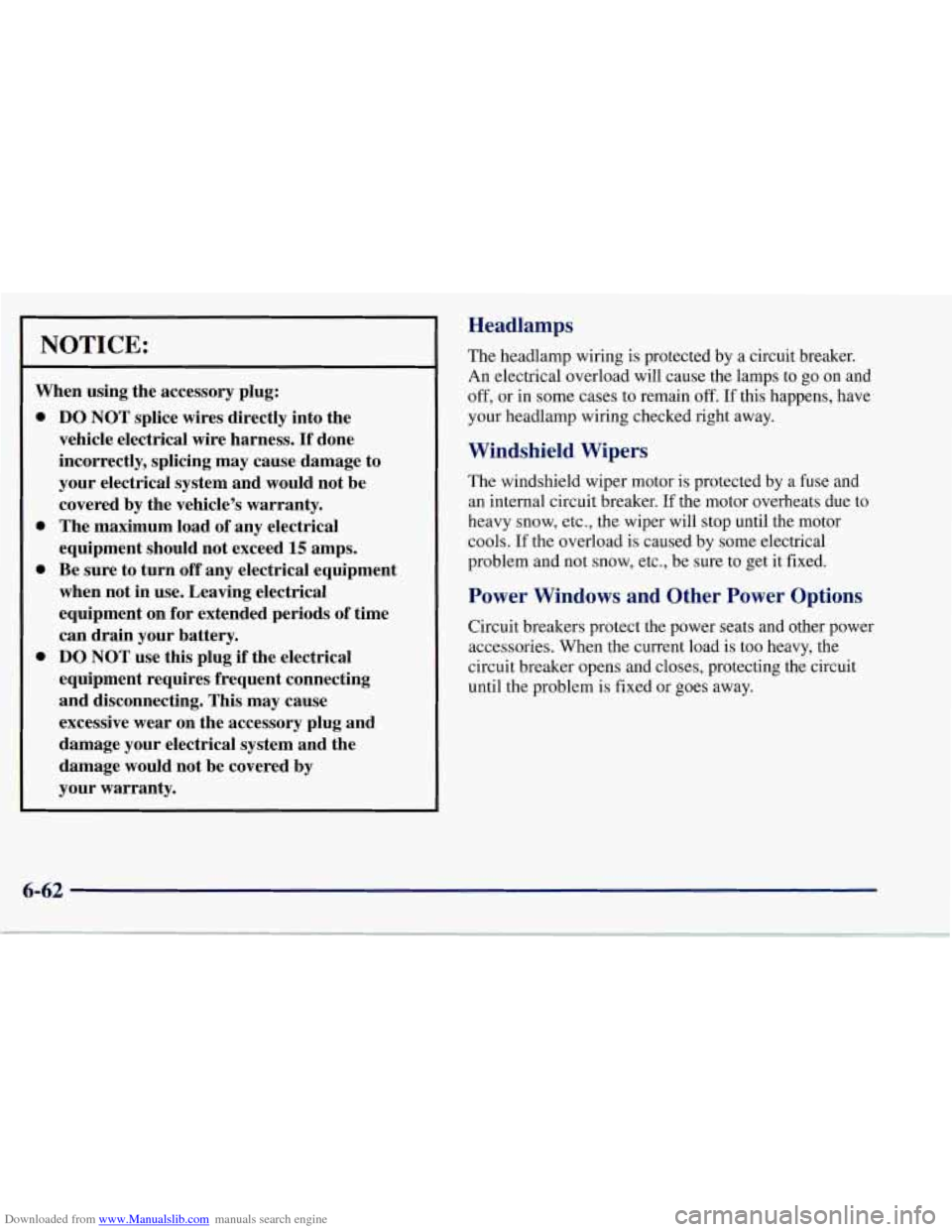
Downloaded from www.Manualslib.com manuals search engine NOTICE:
When using the accessory plug:
0
0
0
0
DO NOT splice wires directly into the
vehicle electrical wire harness.
If done
incorrectly, splicing may cause damage to
your electrical system and would not be
covered by the vehicle’s warranty.
The maximum load of any electrical
equipment should not exceed
15 amps.
Be sure to turn off any electrical equipment
when not in use. Leaving electrical
equipment on for extended periods of time
can drain your battery.
DO NOT use this plug if the electrical
equipment requires frequent connecting
and disconnecting. This may cause
excessive wear on the accessory plug and
damage your electrical system and the
damage would not be covered by
your warranty.
Headlamps
The headlamp wiring is protected by a circuit breaker.
An electrical overload will cause the lamps to go on and
off, or in some cases to remain off. If this happens, have
your headlamp wiring checked right away.
Windshield Wipers
The windshield wiper motor is protected by a fuse and
an internal circuit breaker.
If the motor overheats due to
heavy snow, etc., the wiper will stop until the motor
cools. If the overload
is caused by some electrical
problem and not snow, etc., be sure to get
it fixed.
Power Windows and Other Power Options
Circuit breakers protect the power seats and other power
accessories. When the current load is too heavy, the
circuit breaker opens and closes, protecting the circuit
until the problem is fixed or goes away.
6-62
Page 298 of 356
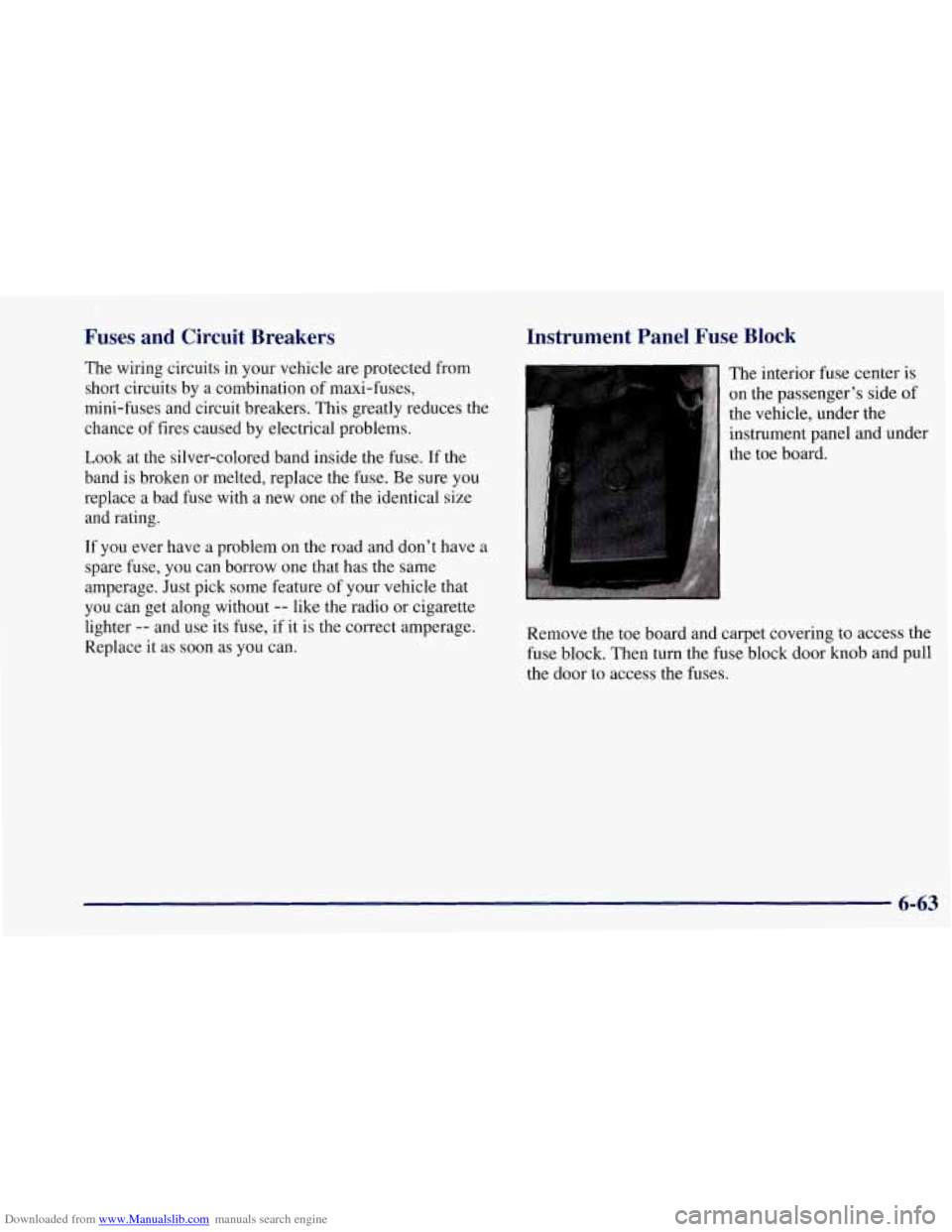
Downloaded from www.Manualslib.com manuals search engine Fuses and Circuit Breakers
The wiring circuits in your vehicle are protected from
short circuits by a combination of maxi-fuses,
mini-fuses and circuit breakers. This greatly reduces the
chance of fires caused by electrical problems.
Look at the silver-colored band inside the fuse. If the
band is broken or melted, replace the fuse. Be sure you
replace a bad fuse with a new one of the identical size
and rating.
If you ever have a problem on the road and don’t have a
spare fuse, you can borrow one that has the same
amperage. Just pick some feature of your vehicle that
you can get along without
-- like the radio or cigarette
lighter
-- and use its fuse, if it is the correct amperage.
Replace it as soon as you can.
Instrument Panel Fuse Block
The interior fuse center is
on the passenger’s side of
the vehicle, under the
instrument panel and under
the toe board.
Remove the toe board and carpet covering
to access the
fuse block. Then turn the fuse block door
knob and pull
the door to access the fuses.
6-63
Page 299 of 356
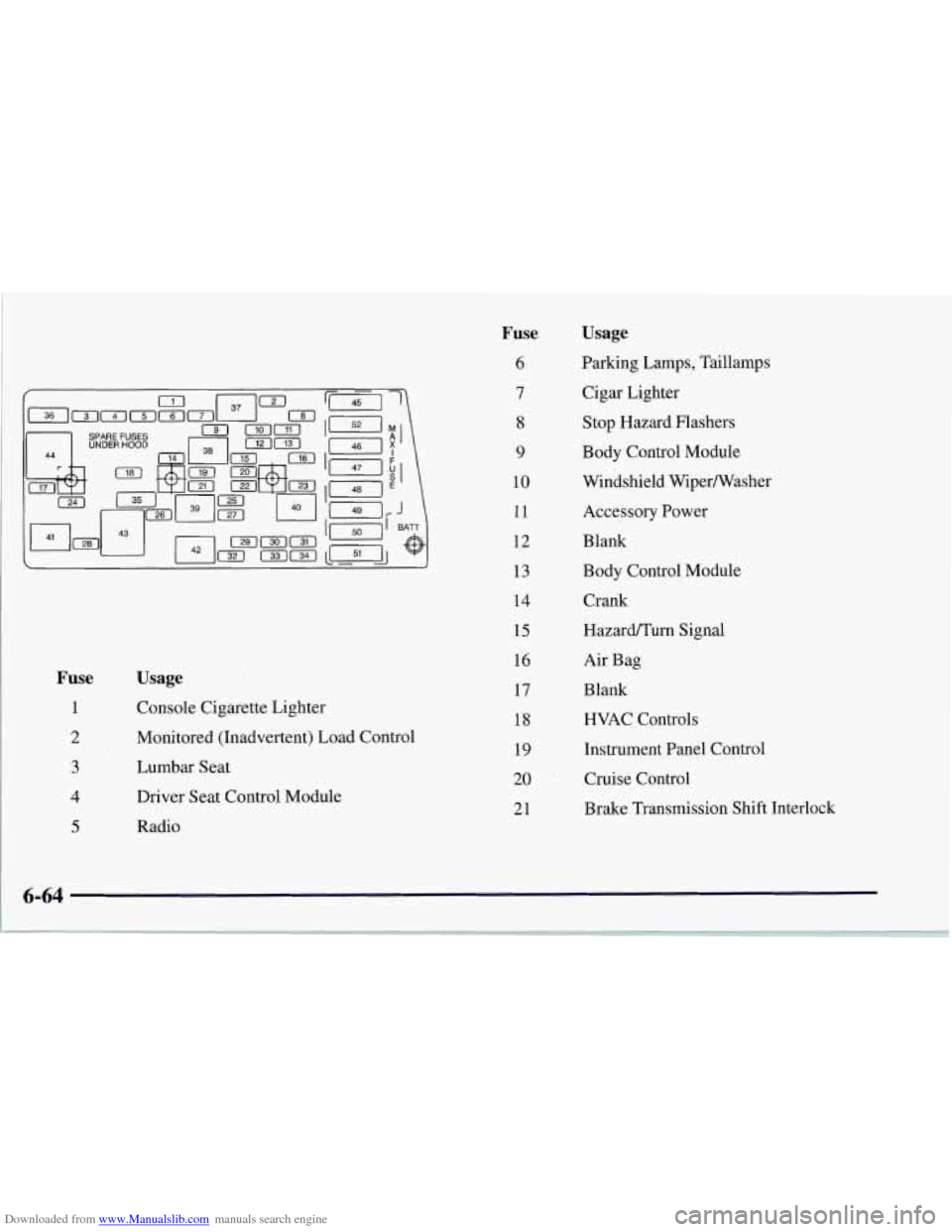
Downloaded from www.Manualslib.com manuals search engine /
p4mrnm
SPAREFUSES UNDER HOOD
Fuse Usage
1 Console Cigarette Lighter
2 Monitored (Inadvertent) Load Control
3 Lumbar Seat
4 Driver Seat Control Module
5 Radio
Fuse
6
7
8
9
10
11
12
13
14
15 16
17
18
19
20
21
Usage
Parking Lamps, Taillamps
Cigar Lighter
Stop Hazard Flashers
Body Control Module
Windshield Wipermasher
Accessory Power
Blank Body Control Module
Crank
Hazard/Turn Signal
Air Bag
Blank HVAC Controls
Instrument Panel Control
Cruise Control
Brake Transmission Shift Interlock
6-64
~ . . -
Page 300 of 356
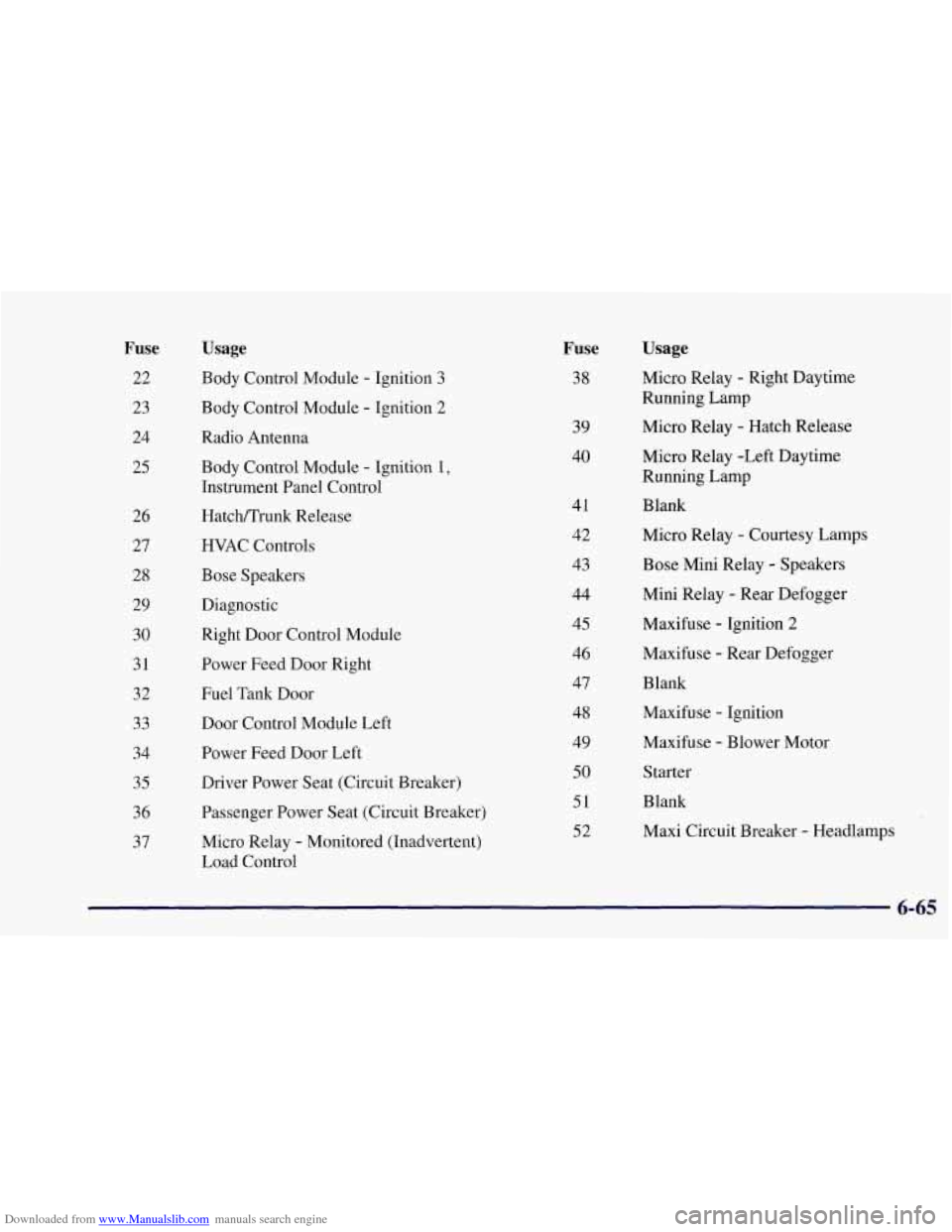
Downloaded from www.Manualslib.com manuals search engine Fuse
22
23
24
25
26
27
28
29
30
31
32
33
34
35 36
37
Usage
Body Control Module - Ignition 3
Body Control Module - Ignition 2
Radio Antenna
Body Control Module
- Ignition I,
Instrument Panel Control
Hatch/Trunk Release
HVAC Controls
Bose Speakers
Diagnostic
Right Door Control Module Power Feed Door Right
Fuel Tank Door
Door Control Module Left
Power Feed Door Left
Driver Power Seat (Circuit Breaker)
Passenger Power Seat (Circuit Breaker)
Micro Relay
- Monitored (Inadvertent)
Load Control 41
42
43
44
45
46
47
48
49
50
51
52
39
40
Fuse Usage
38 Micro Relay - Right Daytime
Running Lamp
Micro Relay
- Hatch Release
Micro Relay -Left Daytime
Running Lamp
Blank
Micro Relay
- Courtesy Lamps
Bose Mini Relay
- Speakers
Mini Relay
- Rear Defogger
Maxifuse
- Ignition 2
Maxifuse - Rear Defogger
Blank
Maxifuse
- Ignition
Maxifuse
- Blower Motor
Starter
Blank Maxi Circuit Breaker
- Headlamps
6-65